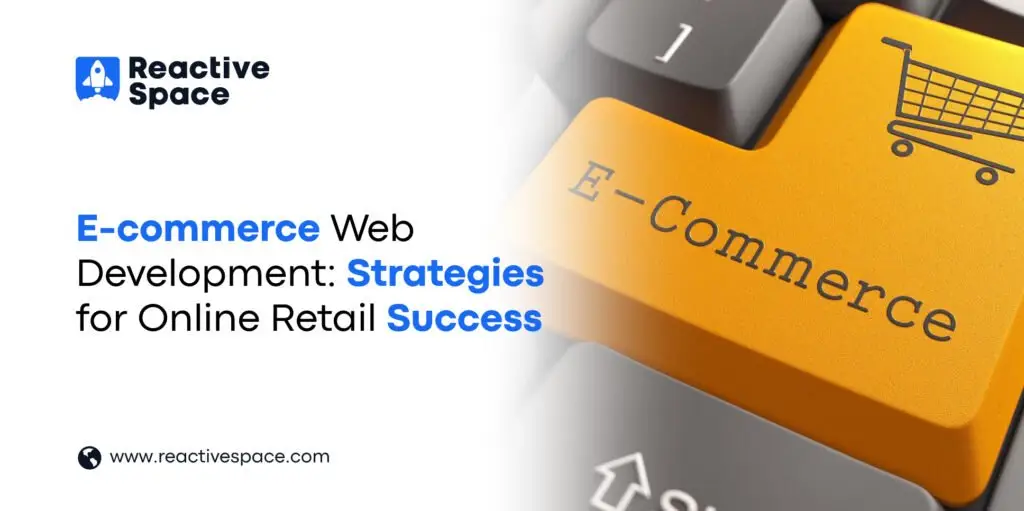
In today’s digital age, e-commerce has transformed the way we shop, offering convenience, variety, and accessibility like never before. With the exponential growth of online retail, having a well-designed and optimized e-commerce website is important for businesses. Working to establish a strong online presence in this blog, we will explore key strategies for e-commerce web development that can help businesses achieve success in the world of online retail.
What is E-commerce?
E-commerce, or electronic commerce, simply means buying and selling stuff online. It covers a wide range of transactions like online shopping, business-to-business deals, auctions, and even digital downloads. With e-commerce, you can buy and sell without needing to meet face-to-face. It’s all about convenience, efficiency, and often global reach. You can find e-commerce everywhere, from online stores and apps to digital payment methods. It’s booming thanks to tech progress, shifts in how people shop, and the desire for easier online experiences.
What is web Development?
Web development is the process of creating and managing websites or web applications that people can access on the Internet. It involves many tasks like designing the look of the site, adding content, and making sure it works smoothly. Web developers use special languages like HTML, CSS, and JavaScript to build the structure, appearance, and functions of websites. They also use tools and systems to make the development process easier and improve how users interact with the site. Web development covers both the parts of the website users see (front-end) and the behind-the-scenes work that makes everything run smoothly (back-end). This ensures that websites work well and look good on different devices and browsers.
Strategies for online success:
To succeed in online retail, businesses need to implement effective strategies that can be used to handle the unique challenges and opportunities of e-commerce. Here are some key strategies for online retail success:
User-Focused Design:
The foundation of any successful e-commerce website is a user-focused design. This involves creating an ideal and built-in user experience (UX) that guides visitors through the shopping journey effortlessly. From easy navigation to clear product categorization and a streamlined checkout process, every aspect of the website should be designed with the user in mind. Incorporating responsive design elements is also essential to ensure optimal performance across all devices, including smartphones, tablets, and desktops.
High-Quality Product Imagery and Descriptions:
In the world of online shopping, visuals play a critical role in influencing purchasing decisions. That is why it’s important to display products with top-notch images from various perspectives, giving customers a clear picture of what they’re getting. Moreover, attractive product descriptions that spotlight important features, and details empower customers to make confident choices. By investing in professional product photography and persuasive copywriting, enhances your online store’s appearance and attracts happier customers.
Smooth Checkout Experience:
E-commerce sites often struggle with cart rejection, frequently caused by a lengthy and complicated checkout experience. To tackle this challenge, prioritize crafting a smooth and hassle-free checkout journey for customers. This means simplifying the checkout process, providing guest checkout alternatives, and supporting various payment gateways for added ease. Displaying trust indicators like security badges and SSL certificates builds customer confidence, encouraging them to finalize their purchases. With a user-friendly checkout process, you can reduce cart rejection rates and boost overall conversion rates on your e-commerce platform.
Personalization and Customization:
Personalization is key to enhancing the shopping experience and gathering customer loyalty. Implementing features such as personalized product recommendations based on browsing history and past purchases can help increase engagement and drive conversions. Additionally, offering customization options, such as product variations and personalized packaging, allows customers to modify their purchases to their preferences, resulting in a more personalized shopping experience.
Robust Security Measures:
Security is most important in e-commerce web development to protect sensitive customer information and build trust with online shoppers. Implementing robust security measures, such as Secure Sockets Layer (SSL) encryption, PCI compliance, and fraud prevention tools, helps safeguard customer data and prevent unauthorized access to sensitive information. Displaying trust badges and security seals prominently on the website can assure customers about the safety of their transactions and encourage them to complete purchases with confidence.
Smooth Integration with Third-Party Tools:
To enhance the functionality of your e-commerce website, consider integrating it with third-party tools and platforms, such as inventory management systems, CRM software, email marketing platforms, and social media channels. Smooth integration allows for the automation of various processes, such as inventory updates, order fulfillment, and customer communication, streamlining operations and improving overall efficiency.
Ongoing Optimization and Testing:
E-commerce web development is an ongoing process that requires continuous optimization and testing to ensure the best performance and effectiveness. Regularly monitor website analytics to identify areas for improvement and conduct A/B testing to experiment with different elements such as page layouts, CTAs, and product placement. By analyzing data and testing theories, businesses can refine their e-commerce strategies and drive sustainable growth over time.
Conclusion:
Effective e-commerce web development is established on a strategy of user experience, functionality, security, and optimization. By implementing these core strategies, companies can create engaging and customer-focused online shopping experiences that captivate customers, conversational growth, and ultimately achieve success in the online market. With a thoughtful approach to design, technology integration, and marketing initiatives, businesses can position themselves for growth and stay agile in the e-commerce market. By prioritizing the needs and preferences of their target audience, businesses can create a smooth and engaging online shopping experience that manages sustainable growth and profit.
Elevate Your Online Store
Unleash the potential of your e-commerce business with our expert web development services
Get Started Now


